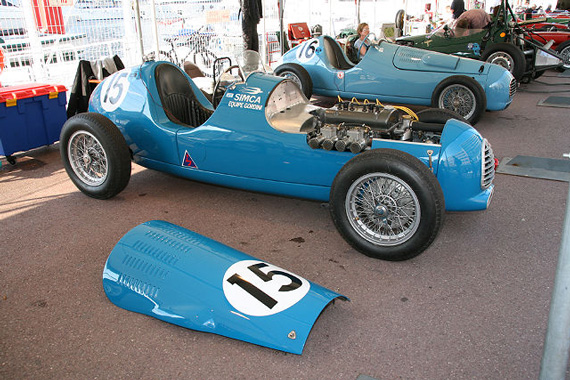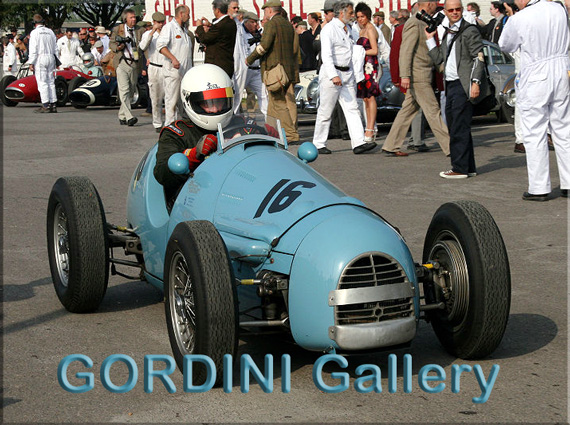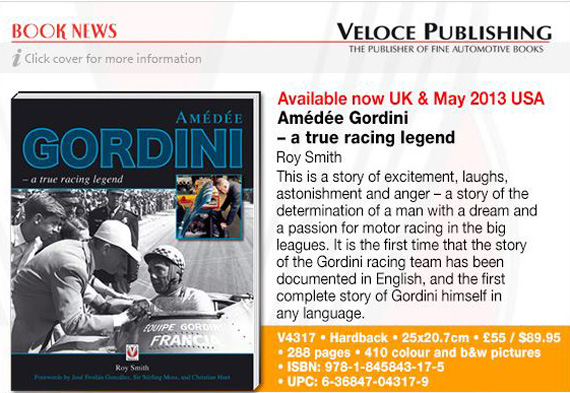By Pete Vack
Photos by Hugues Vanhoolandt
Recently we published two articles about Gordini before WWII., Gauld on Gordini and Gordini Before the Big One. This week, Hugues Vanhoolandt gives us a post war Gordini Gallery, consisting of photos taken all over Europe since 2008.
Before VeloceToday contributor Roy Smith wrote his latest book, Gordini, the only source of in depth information about the cars was ChristianHuet’s amazing book, on the subject. Published in 1984 in French, Huet traced the history of Gordini, plus all known cars.
Huet’s task was made a bit easier because there were very few Gordinis ever built; every chassis was a race car so race events and photos provided a field for research. In 1957, when Amedee Gordini retired his cars from racing and went to work with Renault, he wisely sold many of the remaining Gordinis to museums throughout France. The largest recipients of were the Schlumpf brothers, who in 1960 came into the possession of 13 of the 32 post war Gordinis. Other cars were kept by their owners, hidden away until it became affordable to have them restored.
While at the very same time Ferrari blithely went about destroying his old racecars, the Gordini’s enshrined in the museums ensured that his remarkable and beautiful jewels would never die, enhancing his own legacy and history. Since the 1990s, many of the ex-museum cars have come into the hands of those who wish to see them in action once more. Some 56 years after Gordini retired his cars, a few now appear at selected events such as the Monaco Historics and Goodwood. Few, if any, can be seen in the US, although in 2001 one did appear at the Monterey Historics.
Gordini’s cars were a unique combination; French, Italian, exquisite and fast. The rarity and successful race records plus the drivers such as Behra and Fangio, make them as desirable as a mid-fifties classic could possibly be. Information, photos, specs, and tests were sparse and even less well known in the U.S. Fred Wacker was one of the few Americans who actively raced a Gordini, and he did so in Europe. Gordini brought cars to race in the Carrera Panamericana but the cars returned to France. For years, Gordinis remained mysterious and unknown, and since most were in museums, few ventured out to vintage race car events.
As related in our earlier articles, Gordini was supported heavily by the new Simca company prior to the war. This support continued after WWII and the cars were known as Simca Gordinis. Then came the disastrous 1951 Le Mans, when all four 1500cc Gordinis retired. It was too much for Simca’s M. Pigozzi; he pulled his financial support for Gordini and from that point on the cars were known only as Gordinis.
A note about chassis numbers and Types. Postwar, Gordini created an 1100cc formula car much like the Cisitalia D46. These were called T11s. Over the years most T11s were modified and upgraded to T15 which were, for the most part, 1490cc. T15s were often upgraded or changed to sports racers, such as 18s. Each had a unique chassis number, generally in order of initial construction; 02 GCs, 06 GS, 18GC, etc. The letter ‘s’ after the numbers or suffix would mean a sports model. Engines had Types as well, T15 at just under 1500cc being the most common. Almost all chassis had a “immatriculation” number, or license tag. It can get confusing and thankfully in this case there are only 32 chassis to track, and all the work has been done by Huet and recently updated by Roy Smith in his new book on Gordini. (Smith’s book is completely different and takes the Gordini saga right through to the Renault years and beyond.) We’ve asked Roy to check our assumptions below and we thank him for his corrections. However, that does not guarantee that all of the below information is 100 % correct.
Note that Ed McDonough will be featured driving s/n 19GCS coming up in VT, and we’ll take a much closer look at s/n 33 in the near future.
Finally, thanks to our man Hugues Vanhoolandt, we are able to present these Gordinis for this article. I imagine he has been wondering if we’d ever use them!
Gordini Gallery
Chassis number 02GC
Number 15 is a monoposto, original chassis number 02GC, constructed in 1947. It was driven by Gordini himself at the Torino GP in 1946, before he decided to retire from racing. Maurice Trintignant also took part to some races in this particular car. Driven at Monaco in 2008 by Jean-Jacques Bailly (F).

02GC began life as an 1100 cc, but today has a DOHC Gordini head, bigger wheels and tires for the extra power. Almost all Gordinis were upgraded through the years.

